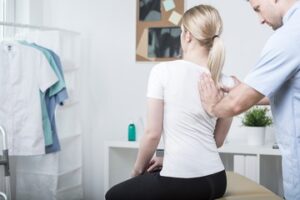Massage Therapy Tulsa is a growing field that has a broad range of applications. It encompasses modalities from Eastern healing and energy flow to deep muscle work. Massage therapists can find employment in spas, fitness centers, hotels, and medical offices.

Massage triggers the parasympathetic nervous system, which calms the body and reduces stress. It also improves sleep and boosts immunity by increasing the production of killer T cells.
Stress is a normal part of life, but it can be harmful when it persists over a long period of time. A body under constant stress can become apathetic and lose its ability to experience pleasure and joy, and it can also negatively affect the reproductive system. In addition, many people suffering from chronic stress often have difficulty sleeping, which can further contribute to their health problems.
Luckily, our bodies have a built-in system for dealing with stress, and massage therapy is a great way to activate it. Researchers have discovered that just 10 minutes of relaxation can trigger the parasympathetic nervous system, which is responsible for calming the body and restoring balance.
Massage can help to decrease stress in the body by lowering heart rate, relaxing muscles and stimulating feel good hormones like serotonin. It also increases circulation which helps to lower blood pressure by reducing strain on the cardiovascular system.
When a person is stressed, they produce a lot of cortisol in their body. This hormone inhibits the brain’s use of glucose, and it also curbs functions that aren’t necessary in a fight-or-flight situation. Massage can decrease cortisol levels by triggering the release of feel good hormones, and it also encourages the body to use its energy more efficiently.
Additionally, massage has been shown to stimulate the production of 5-HIAA, a chemical that’s linked to positive mood and reduced depression. These biochemical changes concur with self-reports of decreased stress and anxiety among massaged women.
While the results of the studies reviewed in this report are encouraging, more research is needed to establish the efficacy of massage on physiological measures of stress, including salivary cortisol and heart rate. In addition, the research should focus on comparing the effects of different types of massage techniques. It’s also important that the studies incorporate methodological rigor and integrity to increase public confidence in their statistical findings. Larger, randomized controlled trials would be ideal.
Relieves Pain
Massage is a touch therapy which can stimulate nerves to block pain signals from the brain. It can also cause the release of chemicals such as endorphins that act as natural pain killers. In addition, it can increase the circulation of blood and lymph around the body. This helps bring in needed nutrients and removes waste products, making muscles more flexible.
A massage can have a number of benefits for people with chronic pain, including helping them sleep better. It can also reduce the stress that is often associated with chronic pain. In one study, people with back pain who received a 60-minute massage session two or three times a week reported less pain than those who did not receive massage therapy.
Many types of massage can relieve pain, but the type and amount of pressure used during a treatment is important. A deep tissue massage may cause some discomfort, but the therapist will monitor your response and be sure to use only as much pressure as you can tolerate.
Research has shown that massage can decrease the sympathetic nervous system (the part of the brain that controls your fight or flight reaction) activity and increase parasympathetic (relaxation) activities, which help to relax the body and mind. Getting a regular massage can also decrease cortisol levels and increase serotonin, which is thought to improve mood.
During massage, the friction between the skin and the fingers and hands causes the blood flow to increase in the treated area. This brings in more oxygen and nutrients to the muscle cells, reducing swelling and inflammation and causing the muscle fibers to stretch and lengthen. Massage can also help to break up adhesions and scar tissue that can cause long term pain.
In the acute care setting, it is common for medical professionals to only use touch during procedures or as a way to distract a patient from pain. Massage can be a good way to break this pattern and give patients a chance to explore and experience the healing power of touch in a safe environment.
Reduces Anxiety
Stress is a normal human response to situations that the body and mind find overwhelming or frightening. While it is impossible to eliminate all stress from your life, massage therapy can help you manage it. It decreases the symptoms of anxiety and depression by reducing cortisol levels, improving moods by increasing the release of feel-good hormones like serotonin and oxytocin, and by activating the part of the brain associated with relaxation.
A meta-analysis of 17 clinical trials found that massage therapy reduces systolic blood pressure and heart rate, and increases the level of oxygen in the blood, both of which are associated with reduced anxiety and increased mood. In addition, the manipulation of soft tissue releases endorphins, which are natural painkillers and can block painful signals from being transmitted to the brain. However, the type and intensity of massage may influence the effectiveness in reducing anxiety.
If you are considering incorporating massage into your treatment plan for anxiety or depression, it is important to find a licensed, certified massage therapist who is experienced in treating these conditions. You can get a personal recommendation for a massage therapist from your doctor or a friend, or you can search online. Before you schedule your first massage session, ask for a list of qualifications and certifications, as well as any restrictions or contraindications.
One randomized study found that cancer patients receiving radiation treatment experienced a significant reduction in their anxiety levels after 10 massage sessions compared to a control group. The patients in the massage therapy group also had lower systolic blood pressure than the control group.
Another randomized trial found that back massage significantly reduced anxiety in patients with chronic heart failure. The participants in the massage therapy group reported a decline in their immediate anxiety scores using the Visual Analogue Scale (VAS), but there was no difference in intermediate-term anxiety levels between the two groups.
Anecdotal evidence, a history of widespread use in many cultures, and positive results from open trials suggest that regular massage can significantly decrease the severity of moderate anxiety disorder, including anxiety related to test-taking or problem solving, and improves mood in those anticipating invasive medical procedures.
Improves Sleep
Getting a good night’s sleep is essential for optimal health. Insufficient sleep can lead to a variety of health problems including high blood pressure, heart disease and chronic pain. Fortunately, massage therapy can improve your sleep by relieving tension, reducing stress and anxiety, and stimulating the production of serotonin.
In a clinical study, participants receiving massage had higher levels of the neurotransmitter serotonin, which is a precursor to melatonin. This hormone promotes sleep by sending signals to the brain that it’s time to wind down and go to bed. Massage has also been shown to reduce the symptoms of insomnia, a common sleeping disorder that causes people to wake up frequently during the night.
Research suggests that massage may be an effective treatment for conditions that cause poor sleep, such as obstructive sleep apnea and low back pain. In one study, researchers found that massage significantly reduced the snoring and sleep apnea frequency of patients with obstructive sleep apnea who were receiving medication. It also improved the quality of sleep and decreased snoring intensity in patients with low back pain resulting from degenerative changes or fibromyalgia.
For those experiencing insomnia or a chronic pain condition, incorporating massage into your routine can help you get a better night’s sleep by promoting relaxation and reducing stress. Combined with other relaxation techniques, such as deep breathing exercises, meditation and gentle stretching, massage can pave the way for a restful and restorative sleep.
For women going through perimenopause or menopause, fluctuating estrogen levels can interfere with sleep patterns and make it difficult to fall asleep. But a good night’s sleep is essential to maintain a healthy lifestyle, especially during this life transition. Luckily, research suggests that massage can help you achieve a more restful slumber by reducing stress and boosting serotonin and dopamine levels, which are precursors to melatonin.








